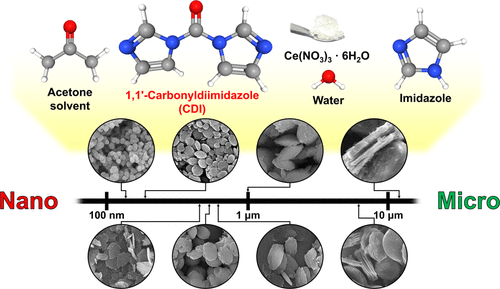Our official English website, www.x-mol.net, welcomes your
feedback! (Note: you will need to create a separate account there.)
Facile Room-Temperature Synthesis of Cerium Carbonate and Cerium Oxide Nano- and Microparticles Using 1,1′-Carbonyldiimidazole and Imidazole in a Nonaqueous Solvent
ACS Omega ( IF 3.7 ) Pub Date : 2021-09-28 , DOI: 10.1021/acsomega.1c03700 Seung Woo Choi 1 , Jaeyun Kim 1, 2, 3, 4
ACS Omega ( IF 3.7 ) Pub Date : 2021-09-28 , DOI: 10.1021/acsomega.1c03700 Seung Woo Choi 1 , Jaeyun Kim 1, 2, 3, 4
Affiliation

|
Ceria nanoparticles (CeONPs) are versatile materials due to their unique catalytic properties, and cerium carbonate particles (CeCbPs) have been widely used as precursors for cerium oxide due to their ease of production. Urea is a widely used precipitant and a source of carbonate ions for the synthesis of CeONPs and CeCbPs, and the reaction temperature is important for controlling the rate of urea decomposition. However, the precise control of the temperature is often difficult, especially in large-scale reactions. Herein, we propose a homogeneous precipitation method that uses 1,1′-carbonyldiimidazole (CDI) and imidazole in acetone without heating. The decomposition rate of CDI can be controlled by the amount of water in the reaction mixture. In the synthesis of CeCbPs, unique particle morphologies of plate-, flying-saucer-, and macaron-like shapes and a wide range of sizes from 180 nm to 13 μm can be achieved by adjusting the amount of CDI, imidazole, and water in the reaction. These CeCbPs are transformed into ceria particles by calcination while maintaining their characteristic morphology. Moreover, the direct synthesis of 130 nm spherical CeONPs was possible by decreasing the amount of CDI in the reaction and the mixing time. These nanoparticles exhibited higher production efficiency and superior reactive oxygen species (ROS) scavenging properties compared to the other CeONPs obtained from calcination. These results demonstrate a novel method using CDI and imidazole in the synthesis of CeONPs and CeCbPs without the aid of a heating process, which may be useful in the large-scale synthesis and application of CeO nanomaterials.
中文翻译:

在非水溶剂中使用 1,1'-羰基二咪唑和咪唑在室温下简便地合成碳酸铈和氧化铈纳米和微粒
二氧化铈纳米粒子 (CeONPs) 由于其独特的催化性能而成为通用材料,碳酸铈粒子 (CeCbPs) 因其易于生产而被广泛用作氧化铈的前驱体。尿素是一种广泛使用的沉淀剂和碳酸根离子的来源,用于合成 CeONPs 和 CeCbPs,反应温度对于控制尿素分解速率很重要。然而,温度的精确控制往往很困难,尤其是在大规模反应中。在此,我们提出了一种在丙酮中使用 1,1'-羰基二咪唑 (CDI) 和咪唑而不加热的均相沉淀方法。CDI的分解速度可以通过反应混合物中的水量来控制。在 CeCbPs 的合成中,板状、飞碟状、通过调节反应中CDI、咪唑和水的用量,可以实现马卡龙形状和从180 nm到13 μm的广泛尺寸范围。这些 CeCbP 通过煅烧转化为二氧化铈颗粒,同时保持其特征形态。此外,通过减少反应中的 CDI 量和混合时间,可以直接合成 130 nm 球形 CeONPs。与通过煅烧获得的其他 CeONPs 相比,这些纳米颗粒表现出更高的生产效率和优异的活性氧 (ROS) 清除性能。这些结果证明了一种使用 CDI 和咪唑合成 CeONPs 和 CeCbPs 的新方法,无需加热过程,这可能有助于 CeO 纳米材料的大规模合成和应用。
更新日期:2021-10-12
中文翻译:

在非水溶剂中使用 1,1'-羰基二咪唑和咪唑在室温下简便地合成碳酸铈和氧化铈纳米和微粒
二氧化铈纳米粒子 (CeONPs) 由于其独特的催化性能而成为通用材料,碳酸铈粒子 (CeCbPs) 因其易于生产而被广泛用作氧化铈的前驱体。尿素是一种广泛使用的沉淀剂和碳酸根离子的来源,用于合成 CeONPs 和 CeCbPs,反应温度对于控制尿素分解速率很重要。然而,温度的精确控制往往很困难,尤其是在大规模反应中。在此,我们提出了一种在丙酮中使用 1,1'-羰基二咪唑 (CDI) 和咪唑而不加热的均相沉淀方法。CDI的分解速度可以通过反应混合物中的水量来控制。在 CeCbPs 的合成中,板状、飞碟状、通过调节反应中CDI、咪唑和水的用量,可以实现马卡龙形状和从180 nm到13 μm的广泛尺寸范围。这些 CeCbP 通过煅烧转化为二氧化铈颗粒,同时保持其特征形态。此外,通过减少反应中的 CDI 量和混合时间,可以直接合成 130 nm 球形 CeONPs。与通过煅烧获得的其他 CeONPs 相比,这些纳米颗粒表现出更高的生产效率和优异的活性氧 (ROS) 清除性能。这些结果证明了一种使用 CDI 和咪唑合成 CeONPs 和 CeCbPs 的新方法,无需加热过程,这可能有助于 CeO 纳米材料的大规模合成和应用。





















































 京公网安备 11010802027423号
京公网安备 11010802027423号